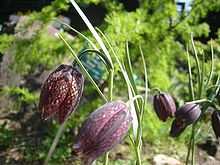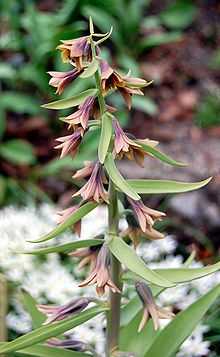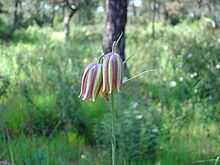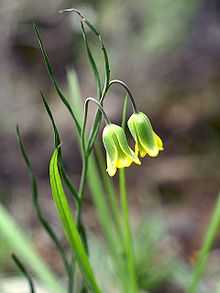Fritillaria
| Fritillaria | |
|---|---|
 | |
| Fritillaria montana | |
| Scientific classification | |
| Kingdom: | Plantae |
| (unranked): | Angiosperms |
| (unranked): | Monocots |
| Order: | Liliales |
| Family: | Liliaceae |
| Subfamily: | Lilioideae |
| Tribe: | Lilieae |
| Genus: | Fritillaria L. |
| Synonyms[1] | |
|
Synonymy
| |
Fritillaria is a genus of Eurasian, North African, and North American plants in the lily family.[1]
There are about 100[2] to 130[3] species of bulbous plants in the family Liliaceae, native to temperate regions of the Northern Hemisphere, especially the Mediterranean, southwest Asia, and western North America.[4] The name is derived from the Latin term for a dice-box (fritillus),[5] and probably refers to the checkered pattern of the flowers of many species. Plants of the genus are known in English as fritillaries. Some North American species are called mission bells.
Description
Fritillaries often have nodding, bell- or cup-shaped flowers, and the majority are spring-flowering. Certain species have flowers that emit disagreeable odors. The scent of Fritillaria imperialis has been called "rather nasty", while that of F. agrestis, known commonly as stink bells, is reminiscent of dog droppings.[6] On the other hand, F. striata has a sweet fragrance.[6]
Uses
Fritillaria extracts are used in traditional Chinese medicine under the name chuan bei mu, and in Latin, bulbus fritillariae cirrhosae. Species such as F. cirrhosa and F. verticillata are used in cough remedies. They are listed as chuān bèi (Chinese: 川貝) or zhè bèi (Chinese: 浙貝), respectively, and are often in formulations combined with extracts of loquat (Eriobotrya japonica).
The major name of herbs and true species listed on the Chinese Pharmacopoeia & National Standards are as follows:[7]
- 川贝母ChuānBèiMǔ BULBUS FRITILLARIAE CIRRHOSAE:
- Classified by shape :松贝 Songbei, 青贝 Qingbei , 炉贝, Cultivated form.
- Classified by species:川贝母 Fritillaria cirrhosa D.Don, 暗紫贝母 Fritillaria unibracteata Hsiao et K.C.Hsia, 甘肃贝母 Fritillaria przewalskii Maxim, 梭砂贝母 Fritillaria delavayi Franch, 太白贝母 Fritillaria taipaiensis P.Y. Li, 瓦布贝母 Fritillaria unibracteata Hsiao et K. C. Hsia var. wabuensis(S. Y. Tang et S. C. Yueh)Z. D. Liu,S. Wang et S. C. Chen
- 浙贝母 ZhèBèiMǔ BULBUS FRITILLARIAE THUNBERGII :浙贝母 Fritillaria thunbergii Miq.
- 伊贝母 YīBèiMǔ BULBUS FRITILLARIAE PALLIDIFLORAE : 新疆贝母Fritillaria walujewii Regel or 伊犁贝母Fritillaria pallidiflora Schrenk
- 湖北贝母 HúBěiBèiMǔ BULBUS FRITILARIAE HUPEHENSIS: 湖北贝母 Fritillaria hupehensis Hsiao et K.C.Hsia
- 平贝母 PingBèiMǔ BULBUS FRITILLARIAE USSURIENSIS : 平贝母 Fritillaria ussuriensis Maxim.
Though there are many local farms which grow the local native Fritillaria species for the market of herb, there are only three companies (1 川贝母ChuānBèiMǔ and 2 平贝母 PingBèiMǔ) which are certified growing under the regulation of the "Good Agricultural Practice for Chinese Crude Drugs" so far.[8]
Fritillaria verticillata bulbs are also traded as bèi mǔ or, in Kampō, baimo (Chinese/Kanji: 貝母, Katakana: バイモ). In one study fritillaria reduced airway inflammation by suppressing cytokines, histamines, and other compounds of inflammatory response.[9]
Most fritillaries contain poisonous alkaloids such as imperialin; some may even be deadly if ingested in quantity. But the bulbs of a few species, such as F. affinis, F. camschatcensis, and F. pudica, are edible if prepared carefully. They were commonly eaten by indigenous peoples of the Pacific Northwest coast.[10]
At least one species, F. assyrica, has a very large genome. With approximately 130,000,000,000 base pairs, it equals the largest known vertebrate animal genome known to date, that of the marbled lungfish (Protopterus aethiopicus), in size.
The emblematic and often unusually-colored fritillaries are commonly used as floral emblems. F. meleagris (snake's head fritillary) is the county flower of Oxfordshire, UK, and the provincial flower of Uppland, Sweden, where it is known as kungsängslilja ("Kungsängen lily"). In Croatia this species is known as kockavica, and the checkerboard pattern of its flowers may have inspired the šahovnica pattern on the nation's coat of arms. F. camschatcensis (Kamchatka fritillary) is the floral emblem of Ishikawa Prefecture and Obihiro City in Japan. Its Japanese name is kuroyuri (クロユリ), meaning "dark lily". F. tenella is the floral emblem of Giardino Botanico Alpino di Pietra Corva, a botanical garden in Italy.
Ecology
The scarlet lily beetle (Lilioceris lilii) eats fritillaries, and may become a pest where these plants are grown in gardens.
Species

- accepted species[1]
- Fritillaria acmopetala – Lebanese fritillary - northwest Turkey, Cyprus, Lebanon, Israel
- Fritillaria affinis – checker lily, chocolate lily syn. F. lanceolata - western USA + British Columbia
- Fritillaria agrestis – stinkbells - California
- Fritillaria alburyana - Turkey
- Fritillaria alfredae - Turkey, Syria, Lebanon
- Fritillaria amabilis - Japan
- Fritillaria amana - Turkey
- Fritillaria anhuiensis S.C.Chen & S.F.Yin - China
- Fritillaria ariana - Iran, Afghanistan, Central Asia
- Fritillaria assyriaca - Iran, Iraq, Turkey
- Fritillaria atrolineata - Iran
- Fritillaria atropurpurea – purple fritillary, spotted fritillary, spotted mountainbells, spotted missionbells - western + central USA
- Fritillaria aurea - Turkey
- Fritillaria ayakoana - Honshu in Japan
- Fritillaria baskilensis - Turkey
- Fritillaria biflora – chocolate lily - Baja California, California
- Fritillaria bithynica - Turkey, Aegean Islands
- Fritillaria brandegeei Eastw. - California
- Fritillaria bucharica - Afghanistan, Tajikistan, Uzbekistan
- Fritillaria byfieldii - Denizli Province in Turkey
- Fritillaria camschatcensis – Kamchatka fritillary, rice lily, skunk lily, outhouse lily, dirty diaper, chocolate lily, Indian rice - Japan, Russian Far East, Alaska, British Columbia, Washington, Oregon
- Fritillaria carica - Turkey, Aegean Islands
- Fritillaria caucasica Adams - Caucasus, Iran, Turkey
- Fritillaria chitralensis - Pakistan, Afghanistan
- Fritillaria chlorantha - Iran
- Fritillaria chlororhabdota - Iran
- Fritillaria cirrhosa D.Don - China, Himalayas, Myanmar
- Fritillaria collina - Caucasus, Turkey
- Fritillaria conica Boiss. - Greece
- Fritillaria crassicaulis S.C.Chen - Sichuan, Yunnan
- Fritillaria crassifolia Boiss. & A. Huet - Iran, Iraq, Turkey, Syria, Lebanon
- Fritillaria dagana Turcz. ex Trautv. - Siberia, Mongolia
- Fritillaria dajinensis S.C.Chen - Sichuan
- Fritillaria davidii Franch. - Sichuan
- Fritillaria davisii Turrill - Greece
- Fritillaria delavayi Franch. - China, Sikkim
- Fritillaria drenovskii Degen & Stoj. - Greece, Bulgaria
- Fritillaria dzhabavae A.P.Khokhr. - Caucasus
- Fritillaria eastwoodiae – Butte County fritillary, Eastwood's ritillary - Oregon, California
- Fritillaria eduardii Regel - Central Asia
- Fritillaria ehrhartii Boiss. & Orph. - Greek Islands
- Fritillaria elwesii - Turkey
- Fritillaria epirotica Turrill ex Rix - Greece
- Fritillaria euboeica Rix - Evvoia (Euboea) Island in Greece
- Fritillaria falcata – talus fritillary - San Benito Co in California
- Fritillaria ferganensis - Kazakhstan, Uzbekistan
- Fritillaria fleischeriana - Turkey
- Fritillaria forbesii - Mugla Province in Turkey
- Fritillaria frankiorum - Turkey, Syria
- Fritillaria fusca Turrill - Tibet
- Fritillaria gentneri – Gentner's fritillary - Oregon
- Fritillaria gibbosa Boiss. - Caucasus, Iran, Afghanistan, Pakistan, Turkmenistan
- Fritillaria glauca – Siskiyou fritillary, Siskiyou missionbells - Oregon, California
- Fritillaria graeca - Greece, Balkans
- Fritillaria grandiflora Grossh. - Caucasus
- Fritillaria gussichiae (Degen & Dörfl.) Rix - Greece, Balkans
- Fritillaria hermonis - Syria, Lebanon
- Fritillaria imperialis – kaiser's crown, crown imperial - Turkey, Iraq, Iran, Afghanistan, Pakistan, Himalayas
- Fritillaria involucrata All. - France, Italy
- Fritillaria japonica - Honshu in Japan
- Fritillaria kaiensis - Honshu in Japan
- Fritillaria karelinii Fischer ex D.Don - Xinjiang, Central Asia
- Fritillaria kittaniae Sorger - Antalya Province in Turkey
- Fritillaria koidzumiana - Iran
- Fritillaria kotschyana Herb. - Iran
- Fritillaria kurdica Boiss. & Noë - Iran, Iraq, Turkey, Caucasus
- Fritillaria lagodechiana - Caucasus
- Fritillaria latakiensis - Turkey, Syria
- Fritillaria latifolia Willd. - Caucasus, Turkey
- Fritillaria legionensis - Spain
- Fritillaria liliacea – fragrant fritillary - California
- Fritillaria lusitanica Wikstr. - Spain, Portugal
- Fritillaria macedonica Bornm. - Albania, Macedonia
- Fritillaria macrocarpa - Morocco
- Fritillaria maximowiczii Freyn - Russian Far East, China, Zabaykalsky Krai
- Fritillaria meleagris – snake's head fritillary, checkered daffodil, frog-cup, Guinea-hen flower, leper lily, - Eurasia from Britain to Altay Krai
- Fritillaria meleagroides Patrin ex Schult.f. - Eurasia from Bulgaria to Xinjiang
- Fritillaria messanensis Raf. - Greece, Italy, Balkans
- Fritillaria michailovskyi Fomin - Turkey
- Fritillaria micrantha – brown fritillary, brown bells - California
- Fritillaria milasensis - Mugla Province in Turkey
- Fritillaria minima - Turkey
- Fritillaria minuta - Turkey, Iran
- Fritillaria monantha Migo - China
- Fritillaria montana Hoppe - Europe from France to Ukraine
- Fritillaria mughlae - Mugla Province in Turkey
- Fritillaria muraiana - Shikoku in Japan
- Fritillaria mutabilis - Greece
- Fritillaria obliqua Ker Gawl. - Greece
- Fritillaria ojaiensis – Ojai fritillary (sometimes included in F. affinis) - California
- Fritillaria olgae Vved. - Tajikistan, Uzbekistan
- Fritillaria olivieri - Iran
- Fritillaria oranensis - North Africa
- Fritillaria orientalis - Caucasus, Turkey, southern + southeastern Europe
- Fritillaria pallidiflora - Kazakhstan, Kyrgyzstan, Xinjiang
- Fritillaria persica - Middle East
- Fritillaria pinardii - Middle East
- Fritillaria pinetorum – pinewoods fritillary, Davidson's fritillary - California
- Fritillaria pluriflora – adobe lily - California
- Fritillaria pontica Wahlenb. - Greece, Turkey, Balkans
- Fritillaria przewalskii Maxim. - China
- Fritillaria pudica – yellow fritillary, yellowbells - western USA + British Columbia
- Fritillaria purdyi Eastw. - Oregon, California
- Fritillaria pyrenaica - Pyrenees in France + Spain
- Fritillaria raddeana Regel - Turkmenistan, Iran, Kashmir
- Fritillaria recurva – scarlet fritillary - Oregon, California, Nevada
- Fritillaria regelii Losinsk. - Tajikistan
- Fritillaria reuteri - Turkey, Iran
- Fritillaria rhodia A.Hansen - Rodhos (Rhodes) Island in Greece
- Fritillaria rhodocanakis Orph. ex Baker - Idhra Island (Hydra) in Greece
- Fritillaria rixii - Greece
- Fritillaria ruthenica - Belarus, Ukraine, Russia, Kazakhstan
- Fritillaria serpenticola - Eskisehir + Antalya Provinces in Turkey
- Fritillaria sewerzowii Regel - Central Asia
- Fritillaria shikokiana - Shikoku + Kyushu in Japan
- Fritillaria sibthorpiana - Turkey, Symi Island in Greece
- Fritillaria sichuanica S.C.Chen - China
- Fritillaria sinica S.C.Chen - Sichuan
- Fritillaria skorpili Velen. - Bulgaria
- Fritillaria sonnikovae - Krasnoyarsk in Russia
- Fritillaria sororum - Turkey
- Fritillaria spetsiotica - Greece
- Fritillaria stenanthera - Central Asia
- Fritillaria straussii - Turkey, Iran
- Fritillaria striata – striped adobe lily - California
- Fritillaria stribrnyi Velen. - Bulgaria, European Turkey
- Fritillaria taipaiensis P.Y.Li - China
- Fritillaria thunbergii Miq. - Tar Bagatai Mountains in Xinjiang + Kazakhstan
- Fritillaria × tokushimensis - Shikoku in Japan
- Fritillaria tortifolia X.Z.Duan & X.J.Zheng - Xinjiang
- Fritillaria tubiformis Gren. & Godr. - Alps in France + Italy
- Fritillaria unibracteata P.K.Hsiao & K.C.Hsia - China
- Fritillaria ussuriensis - Korea, Primorye, northeastern China
- Fritillaria uva-vulpis - Iran, Iraq, Turkey
- Fritillaria verticillata - Japan, Korea, Mongolia, Xinjiang, Kazakhstan, Altay Krai
- Fritillaria viridea Kellogg - California
- Fritillaria viridiflora - Turkey
- Fritillaria walujewii Regel - Xinjiang, Kazakhstan, Kyrgyzstan
- Fritillaria whittallii - Turkey
- Fritillaria yuminensis X.Z.Duan - Xinjiang
- Fritillaria yuzhongensis G.D.Yu & Y.S.Zhou - China
- Formerly included[1]
Numerous names have been coined using the name Fritillaria but referring to species now considered better suited to other genera (Calochortus Disporum Erythronium Eucomis Lilium Notholirion). We provide links to help you find appropriate information.
- Fritillaria autumnalis , now called Eucomis autumnalis
- Fritillaria barbata, now called Calochortus barbatus
- Fritillaria biflora Sessé & Moc 1894 not Lindl. 1834, now called Calochortus barbatus
- Fritillaria cantoniensis, now called Disporum cantoniense
- Fritillaria cuprea, now called Calochortus barbatus
- Fritillaria flavida, now called Lilium nanum var. flavidum
- Fritillaria gardneriana, now called Lilium nanum var. nanum
- Fritillaria hookeri, now called Notholirion macrophyllum
- Fritillaria longifolia Hill 1768 not Steven ex Ledeb. 1852, now called Eucomis autumnalis
- Fritillaria lophophora, now called Lilium lophophorum
- Fritillaria macrophylla, now called Notholirion macrophyllum
- Fritillaria multiscapoidea, now called Erythronium multiscapoideum
- Fritillaria nana, now called Eucomis regia
- Fritillaria oxypetala, now called Nomocharis oxypetala
- Fritillaria punctata, now called Eucomis comosa
- Fritillaria purpurea, now called Calochortus purpureus
- Fritillaria regia, now called Eucomis regia
- Fritillaria souliei, now called Lilium souliei
- Fritillaria stracheyi, now called Lilium nanum
- Fritillaria thomsoniana, now called Notholirion thomsonianum
References
- ↑ 1.0 1.1 1.2 1.3 Kew World Checklist of Selected Plant Families
- ↑ Flora of North America: Fritillaria
- ↑ Flora of China: Fritillaria
- ↑ RHS A-Z encyclopedia of garden plants. United Kingdom: Dorling Kindersley. 2008. p. 1136. ISBN 1405332964.
- ↑ Shorter Oxford English dictionary, 6th ed. United Kingdom: Oxford University Press. 2007. p. 3804. ISBN 0199206872.
- ↑ 6.0 6.1 McGary, J. Fritillaria and the Pacific Garden. Pacific Horticulture 73(2). April, 2012.
- ↑ yuan, Chen shi lin, lin yu lin, guo jia yao dian wei yuan hui, yi ke (2010). Zhong hua ren min gong he guo yao dian zhong yao cai ji yuan zhi wu cai se tu jian. Bei jing: Ren min wei sheng chu ban she. ISBN 9787117129275.
- ↑ "公众服务 > 数据查询 > 公告查询 > 中药材GAP".
- ↑ Yeum, H. S., et al. (2007). Fritillaria cirrhosa, Anemarrhena asphodeloides, lee‐mo‐tang and cyclosporine a inhibit ovalbumin‐induced eosinophil accumulation and Th2‐mediated bronchial hyperresponsiveness in a murine model of asthma. Basic & Clinical Pharmacology & Toxicology 100(3) 205-13.
- ↑ Turner, Nancy; Harriet V. Kuhnlein (1983). "Camas (Camassia spp.) and riceroot (Fritillaria spp.): two Liliaceous "root" foods of the Northwest Coast Indians" (PDF). Ecology of Food and Nutrition 13: 199–219. doi:10.1080/03670244.1983.9990754. Retrieved June 22, 2013.
External links
| Wikimedia Commons has media related to Fritillaria. |
| Wikisource has the text of the 1911 Encyclopædia Britannica article Fritillary. |
- Flora Europaea: Fritillaria
- Treatment of California Fritillaria from the Jepson Manual
- Fritillaria Icones
- Recovery Plan for Fritillaria gentneri (Gentner’s fritillary) U.S. Fish and Wildlife Service
| ||||||||||||||||||||

